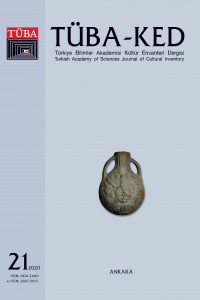Abstract
Osmanlı İmparatorluğu’nun II. Meşrutiyet sonrası dönüşen siyasi ikliminde ortaya çıkıp Cumhuriyet’in ilk yıllarında da devam eden Birinci Ulusal Mimarlık Akımı ya da o dönem yaşayanların verdikleri isimle “Milli Mimari Rönesansı”, betonarme, demir ve çelik gibi yeni inşaat malzemeleri ve teknikleri ile Klasik Osmanlı mimarisinden alınan kubbe, geniş çatı konsolları, kemer, portik, taçkapı gibi mimari unsurlar ile bezeme motiflerini birleştiren bir mimari biçimleniştir. 1910’larda başlayıp 1930’lara dek devam ettiği görülen Klasik Osmanlı mimarlığına dönüş özlemini yansıtan I. Ulusal Mimarlık Akımı’nın ulusçuluk idealleri içinde gelişen ideolojik ortamın bir dışa vurumu olduğu söylenebilir. Cumhuriyet’in kurulmasının ertesinde başkent olarak ilan edilen Ankara’da ve diğer Anadolu kentlerinde de Birinci Ulusal Mimarlık Akımının özelliklerini gösteren yapıların inşasına devam edildiği bilinmektedir. 1920’ler boyunca birçok Anadolu kasabasında akımın daha az tanınan özellikle de hükümet binası, belediye sarayı, okul, banka ve postane olarak kullanılan örneklerinin inşa edildiği bilinmektedir. Balıkesir’in Havran ilçesinde bulunan Belediye Hizmet Binası da bu akımının özelliklerini yansıtan taşrada inşa edilmiş tipik bir örnektir. Bu makalenin amacı; taşrada az sayıda bulunan Birinci Ulusal Mimarlık Akımının özellikleri ile inşa edilmiş bir kültür varlığı olan Havran Belediyesi’nin mimari özelliklerini ve kültürel değerlerini tanımlayıp, tarihsel süreçte gerçekleşen müdahaleleri ve yapıdaki dönemleri gözlenebilen izler ve mimari çizim, eski harita ya da fotoğraf, gazete haberleri gibi arşiv belgeleri ve analojik karşılaştırma ile yorumlayarak belgelemek ve korunması için önerileri tartışmaktır.
Keywords
Birinci Ulusal Mimarlık Akımı Balıkesir Havran Mimari Mirasın Belgelenmesi Koruma Restorasyon
References
- AHUNBAY, Z., 2019, Kültür Mirasını Koruma İlke ve Teknikleri, Yapımevi Yayıncılık İletişim, İstanbul.
- ASLANOĞLU, İ., 2010, Erken Cumhuriyet Dönemi Türk Mimarlığı 1923 – 1938, Bilge Kültür Sanat Yayın Dağıtım, İstanbul.
- BATUR, A., 1983, “Cumhuriyet Döneminde Türk Mimarlığı”, Cumhuriyet Dönemi Türkiye Ansiklopedisi, C. 5, s. 1380-1413, İletişim Yayınları, İstanbul.
- BATUR, A., 2003, M. Vedad Tek Kimliğinin İzinde Bir Mimar, Yapı Kredi Yayınları, İstanbul.
- BOZDOĞAN, S., 2002, “Modernizm ve Ulusun İnşası Erken Cumhuriyet Türkiye’sinde Mimari Kültür”, Metis Yayınları, İstanbul.
- ÇELEBİ, Ü., 2011, Isparta Kenti Kamu Yapılarının İmaj, Kimlik ve Anlam Bağlamında İncelenmesi, (Basılmamış Yüksek Lisans Tezi), Süleyman Demirel Üniversitesi, Isparta.
- EYÜPGİLLER, K. K., 1999, Bir Kent Tarihi: Kastamonu, Eren Yayıncılık, İstanbul.
- GARBIOĞLU, Ö., 2017, “Tanzimat’tan Cumhuriyet’e Hatay’daki Kamu Yapıları”, (Basılmamış Yüksek Lisans Tezi), Mimar Sinan Güzel Sanatlar Üniversitesi, İstanbul.
- Belediyeler Yıllığı, 1949, İller Bankası Yayınları, Ankara.
- KIZILDERE, S., 2005, İstanbul’da Birinci Ulusal Mimarlık Dönemi Yapıları’nın Kent Bütünü İçindeki Yerinin Değerlendirilmesi, (Basılmamış Doktora Tezi), İstanbul Teknik Üniversitesi, İstanbul.
- KOLAY, E., 2013, Amasya İl Merkezinde Geç Dönem Kamu Yapıları, (Basılmamış Yüksek Lisans Tezi), Ondokuz Mayıs Üniversitesi, Samsun.
- KOLAY, E., 2018, Osmanlı Yerel Yönetim Sisteminin Mimari Alana Yansıması:Tanzimat’tan Cumhuriyet’e Belediye Binaları, (Basılmamış Doktora Tezi), Ankara Üniversitesi, Ankara. ORTAYLI, İ., 2012, İmparatorluğun En Uzun Yüzyılı, Timaş Yayınları, İstanbul.
- ÖZER, B., 1964, Rejyonalizm, Üniversalizm ve Çağdaş Mimarimiz Üzerine Bir Deneme, (Doktora Tezi), İstanbul Teknik Üniversitesi, İstanbul.
- SÖZEN, M. / TAPAN, M., 1973, 50 Yılın Türk Mimarisi, Cumhuriyetin Ellinci Yılı Dizisi: 1, Türkiye İş Bankası Kültür Yayınları, İstanbul.
- ŞENTÜRK, N., 2019, Balıkesir Merkez İlçesindeki Kamu Yapıları (19. Yüzyıl – 20. Yüzyıl Başı), (Basılmamış Yüksek Lisans Tezi), Marmara Üniversitesi, İstanbul.
- TEKELİ, İ., 2009, Cumhuriyetin Belediyecilik Öyküsü (1923-1990), Tarih Vakfı Yurt Yayınları, İstanbul.
- YAVUZ, Y., 1981, Birinci Ulusal Mimarlık Dönemi ve Mimar A. Kemalettin Bey, (Doktora Tezi), İstanbul Teknik Üniversitesi, İstanbul.
- YAVUZ, Y., 2009 İmparatorluktan Cumhuriyet’e Mimar Kemalettin 1870- 1927, Kemalettin Bey Anma Programı Dizisi, TMMOB Mimarlar Odası ve T.C. Vakıflar Genel Müdürlüğü Ortak Yayını, Ankara.
- YETKİN, G., 1939, Yurdun Güzel Bir Köşesi Edremit, Edremit Halkevi Neşriyatı, Balıkesir.
Details
| Primary Language | Turkish |
|---|---|
| Subjects | Cultural Studies |
| Journal Section | Research Articles |
| Authors | |
| Publication Date | September 17, 2020 |
| Submission Date | June 1, 2020 |
| Published in Issue | Year 2020 Issue: 21 |
Publisher
Vedat Dalokay Caddesi No: 112 Çankaya 06670 ANKARA
TÜBA-KED Turkish Academy of Sciences Journal of Cultural Inventory (TÜBA-KED) does not officially endorse the views expressed in the articles published in the journal, nor does it guarantee any product or service advertisements that may appear in the print or online versions. The scientific and legal responsibility for the published articles belongs solely to the authors.
Images, figures, tables, and other materials submitted with manuscripts must be original. If previously published, written permission from the copyright holder must be provided for reproduction in both print and online versions. Authors retain the copyright of their works; however, upon publication in the journal, the economic rights and rights of public communication -including adaptation, reproduction, representation, printing, publishing, and distribution rights- are transferred to the Turkish Academy of Sciences (TÜBA), the publisher of the journal. Copyright of all published content (text and visual materials) belongs to the journal in terms of usage and distribution. No payment is made to the authors under the name of copyright or any other title, and no article processing charges are requested. However, the cost of reprints, if requested, is the responsibility of the authors.
In order to promote global open access to scientific knowledge and research, TÜBA allows all content published online (unless otherwise stated) to be freely used by readers, researchers, and institutions. Such use (including linking, downloading, distribution, printing, copying, or reproduction in any medium) is permitted under the Creative Commons Attribution-NonCommercial-NoDerivatives 4.0 International (CC BY-NC-ND 4.0) License, provided that the original work is properly cited, not modified, and not used for commercial purposes. For permission regarding commercial use, please contact the publisher.

